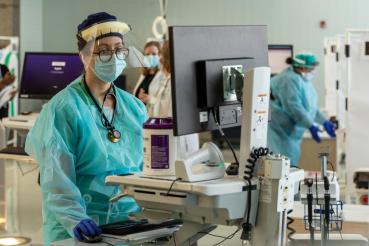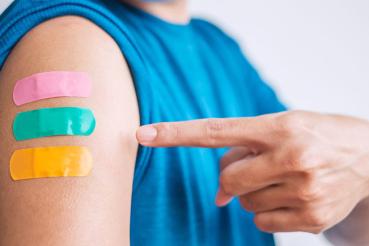COVID-19 is back in the news because of a new omicron subvariant, BA.5, which is particularly good at dodging your immune system’s defenses.
We asked two RUSH experts to explain what’s different about BA.5 and whether upcoming boosters targeting omicron will make a difference.
Why is BA.5 considered the most transmissible variant to date?
“Any time a new variant emerges and starts to become the most prevalent, that is because it’s the most transmissible variant to date,” says Hannah Barbian, PhD, a virologist and genomic epidemiologist for the Regional Innovative Public Health Lab at RUSH. “BA.1, or the original omicron variant, was the most transmissible to date, then it was BA.2, and now we’re on to BA.5. To outcompete the previous variant, a new variant must have some edge in transmissibility.”
Right now, BA.5 accounts for nearly two-thirds of cases in the United States, according to the Centers for Disease Control and Prevention. BA.5 — along with a “companion variant,” BA.4 — are also the dominant variants around much of the globe.
What gives BA.5 an edge in transmissibility?
“The first omicron variant, BA.1, was really good at escaping immune responses because its spike protein had about 30 different mutations, so the antibodies that had previously been able to attach to those spots could no longer bind,” Barbian says. “BA.5 has fewer mutations, but they are in spike regions that are important for antibodies that were effective against omicron. So, it has found this sweet spot that allows it to evade immunity from previous infections."
Do we really know how many people are being infected with BA.5 if many are testing at home now and not reporting the results?
No. “There’s an underestimate of true positive cases now,” Barbian says.
However, public health experts have other ways to predict the spread of BA.5, such as COVID-19 hospitalizations, which have been slowly rising but are still nowhere near the levels during the first wave of BA.1 earlier this year. Another valuable tool is wastewater surveillance that measures the amount of virus in sewage and can help public health officials see the first signs of a potential surge.
Will there be a surge from BA.5 this summer or fall?
“It’s too early to say, but any time there’s a large population who are vulnerable to a new variant, you could see a surge,” Barbian says.
Although the COVID-19 community level for Cook County was recently downgraded to medium, other neighboring counties remain at a high level. Monitoring your COVID-19 community level can help you decide if you want to mask up or add extra layers of protection, especially if you are immunocompromised or are at high risk for severe COVID-19.
If I had COVID-19 earlier this year, am I protected against BA.5?
Maybe, maybe not. “Although your body is still making antibodies against future COVID-19 variants, it might not be enough to prevent infection from BA.5,” Barbian says.
Does BA.5 cause more severe COVID-19 than then original omicron variant?
Based on data from South Africa, BA.5 doesn’t appear to cause more severe COVID-19 than the original omicron variant, BA.1, Barbian says.
Symptoms of BA.5 are also like the original omicron and include fever, chills, cough, trouble breathing, sore throat and fatigue.
Another highly contagious new variant, BA.2.75, has been making headlines. Could it overtake BA.5 as the dominant variant?
While BA.4 and BA.5 have been rising in most parts of the world, India is battling another new variant, BA.2.75.
BA.2.75 has nine new mutations in its spike protein compared with BA.2. This allows it to evade immunity from previous infections or immunizations, Barbian says.
However, India has been affected by different variants than the United States, so we shouldn’t assume that BA.2.75 will become dominant here at home, Barbian says. “BA.2.75 might have more consequence in a place like India that didn’t have a huge BA.1 wave like we did in the U.S.,” she explains. “We should know in a month or so if BA.2.75 is able to compete with BA.5, or if BA.5 will remain more transmissible in the United States.”
So far, only a few BA.2.75 cases have been reported in the United States.
This week, the White House urged eligible Americans to get boosted now. If the latest variants evade immunity, what’s the point of getting vaccinated and boosted now against COVID-19?
“The vaccines are still doing a really good job of preventing serious infection and death, and also hospitalization from COVID-19, “ says Michael Lin, MD, MPH, an infectious disease specialist and associate professor at Rush University Medical Center. “Even throughout all these twists and turns over the past two years, the vaccines have been able to accomplish that very important goal.”
Because the virus continues to mutate, the vaccines currently on the market aren’t a perfect match for the latest variants. That’s why the U.S. Food and Drug Administration has asked vaccine manufacturers to retool their boosters over the next few months so updated versions that target the omicron variants are available this fall.
Who should get the new boosters that will be updated to defend against omicron and its subvariants?
Although the CDC’s Advisory Committee on Immunization Practices has not made any formal recommendations yet, Lin anticipates that most people will be eligible for omicron-specific boosters, although there may be some age restrictions. “People who qualify for current boosters will probably also qualify for these updated boosters when they are available in the fall,” he says.
Lin believes that the new boosters will be especially valuable for people with certain medical conditions who have a higher risk for severe COVID-19.
Will the new boosters actually “match” current variants if the virus continues to mutate?
“The boosters that are being updated for the fall will give us our best chance of being able to catch up to where the virus is right now,” Lin says. “But we may also need to bring back some common-sense mitigation if we start to see cases rise again.”
That could include adding back some layers of protection, such as masking indoors and social distancing, until the threat subsides.
Think you might have COVID-19? Rush On Demand can help you get the care you need today.




